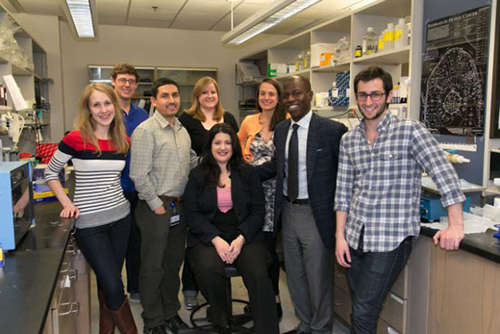Otorhinolaryngology Researchers Unlocking the Secrets of Cell Immortality to Target Cancer and Advance Regenerative Medicine

University of Maryland Department of Otorhinolaryngology researchers Michal Zalzman, PhD (seated) and Rodney Taylor, MD (front row, right of her) are advancing the scientific community’s knowledge of ZSCAN4 to exploit a new target in cancer cells as well as to potentially treat damage of normal tissues with regenerative medicine.
While cells in our body divide to replenish our tissues, the telomeres at the end of their chromosomes act as a biological clock. Telomeres contain repeated sequences of DNA covered with proteins that protect the integrity of the genetic code and become progressively shorter until eventually they are too short to permit further cellular division. This process is also known as cellular aging or senescence. As we age, senescent cells accumulate in our tissues and begin to predominate, leading to age-related disorders and diseases. However, stem cells and cancer cells can activate mechanisms to evade this process.
Finding the Key to an Endless Cellular Lifespan
"ZSCAN4 may be the trigger commonly used during the early stages of embryogenesis and by embryonic stem cells to 'reset' the clock, rebuild telomeres and reverse the effects of cell aging," says Michal Zalzman, PhD, Assistant Professor of Biochemistry and Molecular Biology at the University of Maryland School of Medicine (UMSOM) and a pioneer in stem cell research. Dr. Zalzman holds a secondary research appointment with UMSOM's Department of Otorhinolaryngology.
While then at the National Institutes of Health, Dr. Zalzman discovered the function of the gene ZSCAN4 that imbues mouse embryonic stem cells with the ability to reconstruct and lengthen their telomeres. In effect, ZSCAN4 renders stem cells immortal. Dr. Zalzman's seminal research in this area was published in an article in Nature in 2010.1
ZSCAN4 and Targeting Cancer Cell Immortality
Given that cancer cells have a similar ability to avert the process of cell aging, Dr. Zalzman intuited that they might also express ZSCAN4. She discussed this possibility with Rodney Taylor, MD, MSPH, Associate Professor and Chair of the Department of Otorhinolaryngology at UMSOM, who besides being a head and neck cancer surgeon had research interests in telomere length and cellular aging. In 2013, the two formed a research partnership, collaborating on discovering the mechanism that gives head and neck squamous cell carcinoma cells their indefinite replicative lifespan. In a paper currently under peer review, Dr. Zalzman and Dr. Taylor show that like stem cells, cancer cells utilize the ZSCAN4 gene to avoid cell aging and, ergo, apoptosis. (At senescence, cells develop immunogenic susceptibility and can be readily targeted and destroyed by T cells.) Armed with this knowledge, the research team is now laying the groundwork for targeting ZSCAN4 in cancer cells to develop a new drug approach that takes aim at cancer immortality.
Harnessing the Power of ZSCAN4 for Potential Regenerative Medicine
The work on ZSCAN4 at the University of Maryland also has implications for regenerative medicine. Using small amounts of tonsillar tissue procured by biopsy following tonsillectomies performed at the University of Maryland Medical Center, Dr. Taylor and Dr. Zalzman have generated mesenchymal stem cell (MSC) lines from adults.2 Their team has been able to differentiate these tonsillar MSCs into bone, cartilage and fat cells, including the progenitors of neurons.
"Mesenchymal stem cells tend to live along blood vessels, so the tonsils, which are very vascularized, are a rich source of them," Dr. Taylor says. He points out that most patients do not have access to their umbilical cord – which, along with bone marrow, is another excellent source of MSCs – but if they still have their tonsils, they carry with them a ready and a highly rich source from which their stem cells can be harvested through an in-office biopsy. From the modest quantities of less than a gram of tonsillar tissue collected, University of Maryland researchers were able to cultivate in vitro at least 50 million MSCs from each of their research subjects.
There are potential pros and cons to using MSCs for regenerative purposes. The benefits are that MSCs are more ethical and feasible to source and do not lead to teratoma tumors as other types of stem cells can. However, like normal cells MSCs are susceptible to telomere shortening, and therefore they eventually lose their function and potential for differentiation as patients age. Dr. Zalzman is the principal investigator of R01 and R21 NIH grants that will overcome this obstacle through the application of ZSCAN4 to MSCs so that they will repair and lengthen their telomeres. Specifically, for the R01 grant Dr. Zalzman and Dr. Taylor's team will harness ZSCAN4 so that autologous bone grafts will be made possible. Without the application of ZSCAN4, MSCs can only generate bone tissue grafts of a few millimeters in size, but the team's preliminary lab work has demonstrated that ZSCAN4 looks promising in being able to permit MSCs to develop larger bone grafts cultivated on 3D printed scaffolds that would be clinically useful. The R21 grant is likewise exploring how ZSCAN4 might be applied to MSCs to treat Parkinson's disease.
While many other discoveries in the field of regenerative medicine will need to be made by a concert of research teams before this highly innovative research can be applied clinically, Dr. Zalzman and Dr. Taylor's collaboration has shown that a relatively facilely procured source of tonsillar stem cells has promising potential for being harnessed to repair tissues damaged by injury or disease.
1Zalzman M et al. ZSCAN4 regulates telomere elongation and genomic stability in ES cells. Nature. 2010 Apr 8;464(7290):858-863.
2Khatri R, Arad M, Ortlip T, Portney BA, Meltzer WA, Diaconu S, Silipino LE, Wang Y, Kaetzel DM, Taylor RJ, Zalzman M. Harvesting multipotent progenitor cells from a small sample of tonsillar biopsy for clinical applications. Stem Cell Res Ther. 2017 Jul 2;8(1):174.
